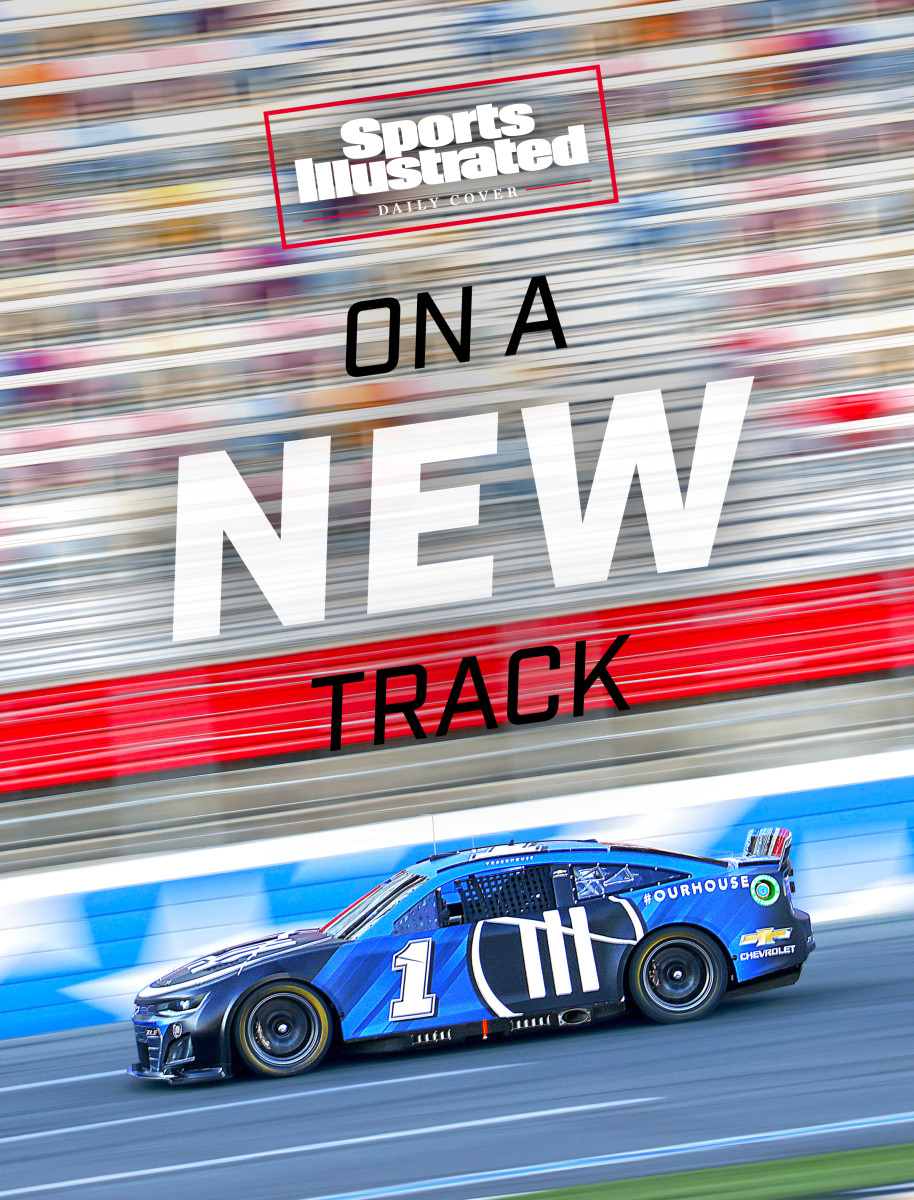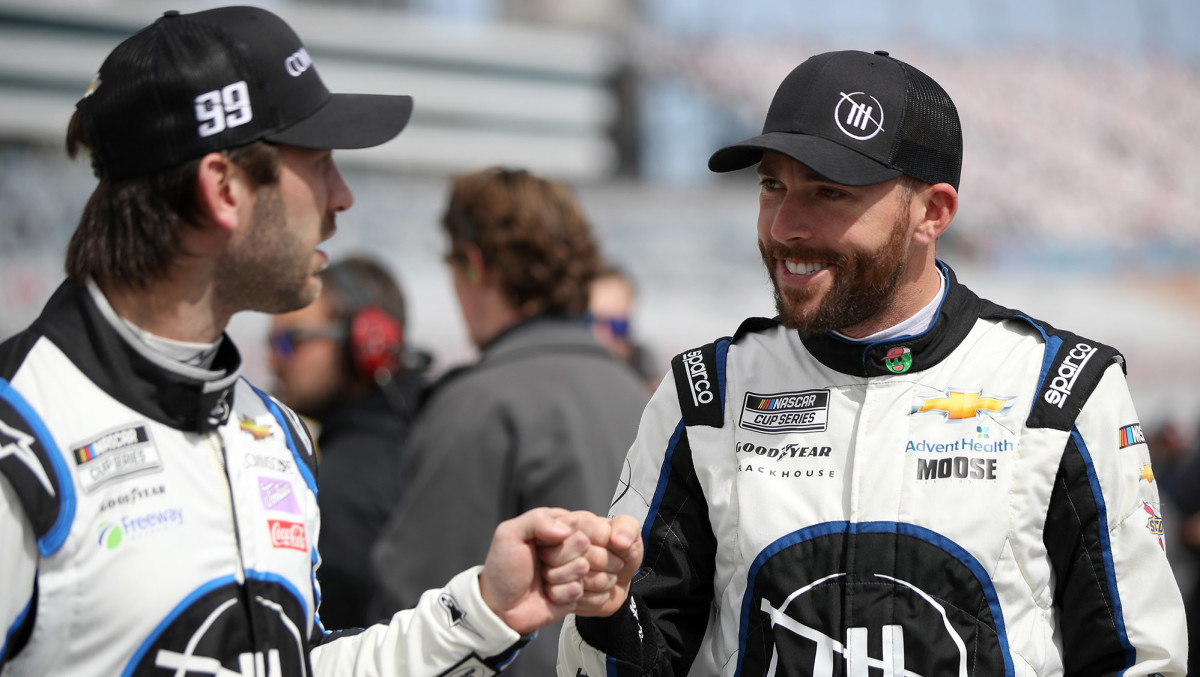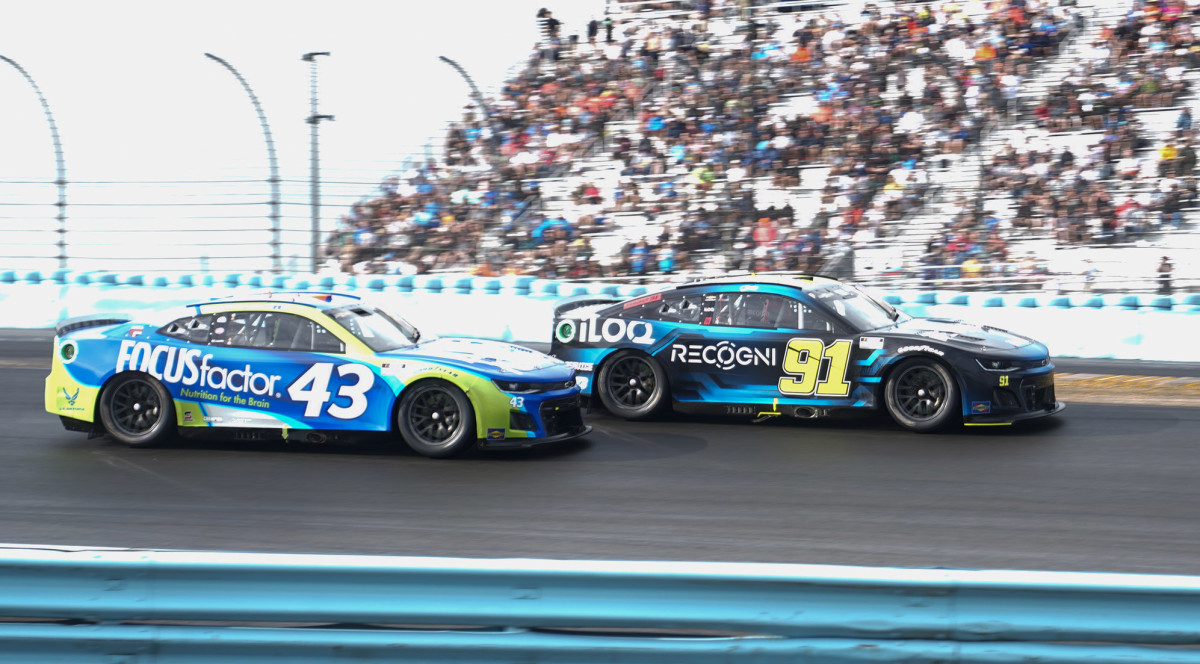How Trackhouse Is Trying to Change NASCAR

It’s hard to miss the Trackhouse Racing logo. While it does have an eye-catching electric-blue flare, the team took a different approach than the rest of the NASCAR Cup Series paddock. Most showcase some variation of its name, whether in full or an abbreviation. However, Trackhouse kept it simple and modern with three lines and a slash through them, encompassed by a circle.
The sleek look mirrors that of a brand, which is how founder Justin Marks created the company. “Trackhouse Racing is a race team that represents what we believe the future of motorsports teams can be, and that’s truly a sports entertainment brand,” he says. “An entity that tells compelling stories and unites a fan base and inspires people.”
In just its second season (and first as a fully autonomous team), Trackhouse not only has three wins to its name but landed both its full-time cars into the second round of the Cup Series playoffs, which is dominated by the legacy teams. A driver from Joe Gibbs Racing, Team Penske, Hendrick Motorsports and Stewart-Haas Racing has won the championship ever since 2005 when Tony Stewart took the title, with the exception of Martin Truex Jr. in ’17.

Fast forward to the 2022 postseason, 12 of the 16 drivers competing for the crown hail from one of the core four teams. Who did Trackhouse bring to the fight? Daniel Suárez, who was born in Mexico and learned English through cartoons, and Ross Chastain, an eighth-generation watermelon farmer who made a few enemies this season with his aggressive driving style.
But, those aren’t the only two names who have competed under the Trackhouse Racing name this season. Formula One world champion Kimi Räikkönen competed for a single race as a part of its international drivers program, Project 91.
Marks saw how a traditional race team worked and decided to create a vision of his own, launching a brand that would be known on and off the track. Suárez describes it as “a lifestyle, a culture that has come to change the sport.” Built with an underdog-type mentality, Trackhouse Racing, which is co-owned by Pitbull (yes, that Pitbull), routinely fought near the top throughout the 2022 season as the Next Gen car leveled the playing field.
“In racing, money wins, and money has always won,” Marks says. “And I think if you’re trying to tell a story that resonates with millions and millions of people around the world, the story can’t be, ‘This rich guy’s beating that rich guy.’”
Marks is not new to the racing scene. The longtime driver went on to own smaller teams, a go-karting facility and a North Carolina–based import distribution company. The 41-year-old has always been curious to see how far he could go on the business side of racing, but says “it was never an interest of mine to go Cup racing until I heard about this new car.”
The Next Gen car has a sleeker look with a fully symmetrical body, which reduces aerodynamic forces on the vehicle. But the biggest change of note is that it eliminated the barriers to entry. Instead of manufacturing the parts themselves, teams purchase the pieces from single sources, ultimately resetting the playing field and eliminating the arms race.
“A new team like Trackhouse could be successful, because we can be set up really more like a team and less like a manufacturing company,” Marks says. “There were no teams that were building a brand of their own and building a fan following of their own. They were all sort of the namesakes of very successful owners. As a result of that, there just weren't really any fans of teams. Fans follow drivers, they follow the sponsors, or the car maker.”

So the concept was to build a brand that would thrive on and off track with the twofold vision of winning races and telling human stories that resonate with not just partners but also fans. “A lot of teams think of themselves as racing teams and try to market well, and I look at Trackhouse as a marketing company that races,” Marks says. He called in NASCAR veteran Ty Norris to be the company’s president of racing operations. Norris has extensive racing history: He formerly served as the executive vice president and general manager of both Dale Earnhardt Inc., where he was The Intimidator’s right-hand man, and Michael Waltrip Racing.
Norris says Trackhouse does about 90% of what NASCAR teams traditionally do, but that last 10% is spent addressing questions like, How do we present ourselves? How do we market ourselves? How do we build a culture within the building that is positive about the sport, positive about each other? And how do we build true teammates as opposed to individual teams under one roof?
Norris remembers flying out to California in 2019 for the first whiteboard session with Marks. The two went to a fabrication shop owned by one of Marks’s friends, and in a conference room, they outlined the concept of Trackhouse Racing. Everything hinged on one issue—NASCAR's commitment to the Next Gen car. After meeting with NASCAR executives, they were convinced. “So I just decided to go for it,” says Marks.
They got the house in order—leased a charter from Spire Motorsports, entered into an engine partnership with Richard Childress Racing and pinpointed a manufacturer with Chevrolet. They met with a brand team and discussed parameters for forming what would be called Trackhouse. They didn’t want racing or motorsports in the name in order to avoid niching themselves, and they wanted to own a color.
Trackhouse was a two-part approach. Says Norris, “Track can mean everything from dropping the needle on the record to … a track in motor sports. Then, house means home. A house can be a restaurant, a bar, an entertainment venue; [it] can be a race team.” They opted for the bold, electric-blue color. And as for the logo, they combined the T and H with a recognizable slash, something Norris says “is to us like a Nike swoosh. That slash can end up anywhere.”
“When you see Trackhouse, you’ve got to think different, you got to think bold, you got to think innovative and you need to think positive,” Norris says.
With all that decided, they just needed one more thing. Drivers.

Suárez grew up in Monterrey, Nuevo León, Mexico, and while he does not come from a racing family, that didn’t mean he could avoid the adrenaline bug. He hopped into his first go-kart at 10 years old and was immediately hooked.
“If I’m not going to put the effort to do things 100%, I prefer not to do it because I can’t afford to do things halfway,” says Suárez. He rose through the ranks of the NASCAR PEAK Mexico Series before deciding to head north to the United States full time with his eyes set on the Cup Series. He didn’t know any English when he set out on his journey, and without being able to afford classes, Suárez watched cartoons to learn the language. On track, he had to keep grinding and found success early on, winning the 2016 Xfinity Series title in just his second season.
That allowed Suárez the chance to compete at the highest level, but he immediately realized things were going to be different. “Once I went into the Cup Series, I was just operating the same level as an Xfinity Series champion, and it just doesn’t work like that,” he says. “I took for granted how important the people around you are. And I’m not talking only about on your team, but everyone in the company trying to push you in the same direction.”
Suárez struggled and didn’t have many people to give him solid advice. He felt he had to learn on his own. “I kind of knew already what I needed, but I couldn’t fix it,” he says. “I didn’t have the right tools to fix the issue.”
In his first four seasons in the Cup Series, Suárez competed for three different teams. He remembers saying to himself, “If it’s gonna get worse than this, I’m gonna quit racing.” Then came Marks, Norris and Trackhouse Racing.
Marks and Norris were at dinner one night discussing potential drivers when they decided to text Suárez. “If you’re looking at all of the boxes, we need to be different, we need to be bold, we need to take that underdog role. Let’s connect with him and find out where he is,” says Norris. They later met with Suárez and pitched the idea to him.
They only had a blueprint in hand, and the driver had other opportunities with teams that had more than a handful of employees. On paper, it seemed like a no-brainer for Suárez to go elsewhere. Trackhouse, though, had the intention to build the team around him, creating a support system that Suárez longed for.
“Once I got to Cup, I never felt like the organization or the team were listening to me,” he says. “I needed something, and they were telling me to be patient, to just sit on the side and watch. Sometimes, it’s way better to be a big dog in a small place than a small dog in a big place. I knew I was a winner. I knew I was talented to win races, but you need the right tools and the right people around me to be able to make that happen.”
Although the Next Gen car was delayed a season due to the COVID-19 pandemic, Trackhouse decided to compete in 2021. (It was chaotic, but Norris says, “What Justin sees in chaos is opportunity.”)
Suárez had a season-best fourth-place finish at Bristol’s dirt race. Halfway through the season, Trackhouse acquired Chip Ganassi Racing’s NASCAR assets and took control once the campaign was over. That meant it was time to field a second flagship car—the No. 1—and Trackhouse zeroed in on another driver who, in the words of Norris, “toiled around in underfunded teams, just to get enough money to pay for his apartment.” In came Ross Chastain, an eighth-generation watermelon farmer.
“They’re different in every way except one,” Norris says of his two drivers. “They both have always been underdogs, and they both had to create and scratch and claw their way to get to where they are.
“Underdog, it can be overused in some instances,” Norris says. “But when you look at who our two drivers are and [the people] who are affiliated with this team, we’re all people who have had to worry about next week’s check to make sure we can pay our bills and support our families.
“And when you are in that situation, you fight like hell to get what you need.”

Trackhouse has emerged as a destination rather than a midtier stepping stone, embodying what NASCAR’s business model looks like in its next chapter.
In just its second season as part of the Cup Series with two drivers who had yet to see victory lane at this level have grabbed the checkered flag three times. Chastain brought home the first win on the road course in Austin in March, and four races later found victory lane again on the superspeedway in Talladega.
“I’m in a spot that I’ve never been in. I’m in the exact spot that I’ve wanted to be in since I got into the sport in 2011,” Chastain says. “But working to get there and now arriving here are two different things. It’s been challenging for me to accept that we’ve arrived now, and now we’re going to be here for a while.”
Suárez continued the hunt for his own win, which finally came in June in Sonoma.
When the graduate of NASCAR’s Drive for Diversity program entered the Cup series, he became the first Mexican driver to compete at that level. Drivers from his home country have found success in other racing leagues, such as Formula One’s Sergio Pérez. But on that Sunday in June, Suárez made Cup Series history, becoming the first driver born in Mexico to win a race. And it happened to be at a place that he felt an affinity for. “California is like home for me,” he says. “Being from Mexico, every time I go to the West Coast, they made me feel like home.”
Heading into Sunday’s race in Charlotte, which will set the field for the round of 8, Chastain is in third place, while Suárez is seventh.
NASCAR president Steve Phelps feels Trackhouse mirrors where the sport is heading in terms of innovation. He points to how NASCAR was one of the first sports back and competing in front of fans after the COVID-19 pandemic shutdown, how it has taken a stronger position on social justice and diversity equity and inclusion efforts since 2020, and how it became bolder in its scheduling, including competing at the L.A. Coliseum this year and adding a Chicago street race next season.
“I would suggest if we hadn’t done the things we had done in 2020, Michael Jordan [co-owner of 23XI Racing] and Pitbull wouldn’t be here. They want to make sure that we are the welcoming and inclusive fan base that we believe we are. And it’s just not saying; it’s actually doing it through actions,” Phelps says. “I think if you look at what we’ve done in [diversity and inclusion], I think it's authentic to ourselves, but it pushes the boundaries of where people think the DNA of NASCAR probably was.”
Trackhouse pushed a boundary with its Project 91 initiative. When Räikkönen joined Trackhouse Racing at Watkins Glen, it drew plenty of global attention. But it soon became evident there were fans within the paddock as well. Chastain described Räikkönen as a hero of his. When Ryan Blaney entered the media center for his press conference, he asked which seat Räikkönen was previously in and took his spot.
Räikkönen, the 2007 F1 champ who retired last year, ran as high as ninth before ending up in the barriers. “I don’t see anything negative,” said Räikkönen. “I think it’s great. But what Justin [Marks] and the team are doing to give a chance to those from Europe—I’m sure there’s a lot of drivers that would like to have a chance to try it, but it’s not very easy. So maybe it opens some doors, and in the future there’s some kind of chance to try to get more Europeans.”
Marks flew to Switzerland to discuss the idea with Räikkönen, explaining what Trackhouse is about and the idea of Project 91. Räikkönen says, “I kind of knew what they have done as a team and I was happy to help.” The former F1 driver is no stranger to stock car racing, having competed in one-offs in the Truck and Xfinity series back in 2011. The idea was for him to do a Cup Series race then as well, but it didn’t pan out.
Räikkönen worked closely with Suárez when preparing for his Cup debut and says the 30-year-old gave him plenty of advice ranging from tires to pitstops. Suárez was excited about Project 91, saying, “I’m the perfect [example of] Project 91. And the reason for that is because that’s me. I came from a different country with a different culture with a different language, just trying to learn something new, and trying to start breaking those barriers.”
Marks wants to expand Project 91 in future seasons, saying Trackhouse is expecting to do six to eight races in 2023 with the part-time third car. Which other high-profile international drivers will fill the seats is still unknown, and Räikkönen hasn’t fully ruled out a possible return. Within the F1 paddock, there’s plenty of NASCAR fans, like Daniel Ricciardo and Max Verstappen.
“Honestly, none of us knew much about the personalities of Formula One drivers outside of what you see until Drive to Survive,” Norris says. “Then, you hear them talking about NASCAR.… In that world, they look at NASCAR maybe in a certain light, but they look at the Cup Series as the premier opportunity to compete against the greatest in the world in that particular style of racing.”
Marks saw an opportunity as international drivers look to build their brands in the U.S. If they want to run in NASCAR, he says, “Let’s be that destination for them.”
Räikkönen says, “It's so different [than] what we used to, especially in F1.” Would he do it again? “I’m open, more or less,” he says. “Of course, it needs to fit on the family schedule.… I don’t want to be away as I was in F1.… I only have good things to say about it, but who knows what happens in the future?”
As for the present: In just two years, Trackhouse has made a noticeable impact—off the track as well, through charities designed to bring Latinx fans to races, help school classrooms and raise STEM education awareness. But when it comes to racing, can Trackhouse truly be considered an upstart anymore? Chastain says he isn’t buying it. “We’re new, but this isn’t just a flash-in-the-pan moment for Trackhouse,” he says. “I truly believe in the arrival of us, and we’ll be here now for the long haul. I don’t view myself as an underdog anymore.”
• How Austin Riley Became the Cornerstone of the Braves’ Core
